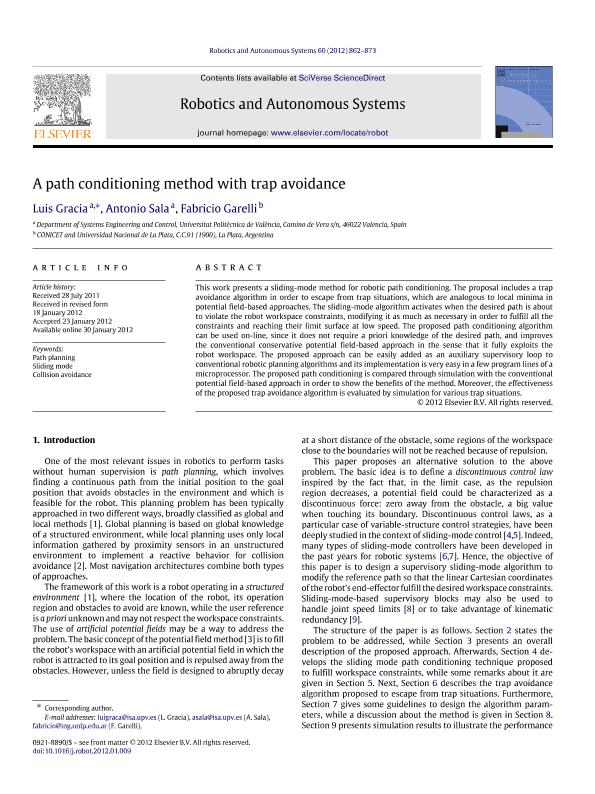Mostrar el registro sencillo del ítem
dc.contributor.author
Gracia, Luis

dc.contributor.author
Sala, Antonio

dc.contributor.author
Garelli, Fabricio

dc.date.available
2019-05-13T23:17:12Z
dc.date.issued
2012-06
dc.identifier.citation
Gracia, Luis; Sala, Antonio; Garelli, Fabricio; A path conditioning method with trap avoidance; Elsevier Science; Robotics And Autonomous Systems; 60; 6; 6-2012; 862-873
dc.identifier.issn
0921-8890
dc.identifier.uri
http://hdl.handle.net/11336/76243
dc.description.abstract
This work presents a sliding-mode method for robotic path conditioning. The proposal includes a trap avoidance algorithm in order to escape from trap situations, which are analogous to local minima in potential field-based approaches. The sliding-mode algorithm activates when the desired path is about to violate the robot workspace constraints, modifying it as much as necessary in order to fulfill all the constraints and reaching their limit surface at low speed. The proposed path conditioning algorithm can be used on-line, since it does not require a priori knowledge of the desired path, and improves the conventional conservative potential field-based approach in the sense that it fully exploits the robot workspace. The proposed approach can be easily added as an auxiliary supervisory loop to conventional robotic planning algorithms and its implementation is very easy in a few program lines of a microprocessor. The proposed path conditioning is compared through simulation with the conventional potential field-based approach in order to show the benefits of the method. Moreover, the effectiveness of the proposed trap avoidance algorithm is evaluated by simulation for various trap situations.
dc.format
application/pdf
dc.language.iso
eng
dc.publisher
Elsevier Science

dc.rights
info:eu-repo/semantics/openAccess
dc.rights.uri
https://creativecommons.org/licenses/by-nc-sa/2.5/ar/
dc.subject
Collision Avoidance
dc.subject
Path Planning
dc.subject
Sliding Mode
dc.subject.classification
Ingeniería de Sistemas y Comunicaciones

dc.subject.classification
Ingeniería Eléctrica, Ingeniería Electrónica e Ingeniería de la Información

dc.subject.classification
INGENIERÍAS Y TECNOLOGÍAS

dc.title
A path conditioning method with trap avoidance
dc.type
info:eu-repo/semantics/article
dc.type
info:ar-repo/semantics/artículo
dc.type
info:eu-repo/semantics/publishedVersion
dc.date.updated
2019-05-08T17:31:11Z
dc.journal.volume
60
dc.journal.number
6
dc.journal.pagination
862-873
dc.journal.pais
Países Bajos

dc.journal.ciudad
Amsterdam
dc.description.fil
Fil: Gracia, Luis. Universidad Politécnica de Valencia; España
dc.description.fil
Fil: Sala, Antonio. Universidad Politécnica de Valencia; España
dc.description.fil
Fil: Garelli, Fabricio. Universidad Nacional de La Plata; Argentina. Consejo Nacional de Investigaciones Científicas y Técnicas. Centro Científico Tecnológico Conicet - La Plata; Argentina
dc.journal.title
Robotics And Autonomous Systems

dc.relation.alternativeid
info:eu-repo/semantics/altIdentifier/doi/http://dx.doi.org/10.1016/j.robot.2012.01.009
dc.relation.alternativeid
info:eu-repo/semantics/altIdentifier/url/https://www.sciencedirect.com/science/article/pii/S0921889012000218
Archivos asociados
